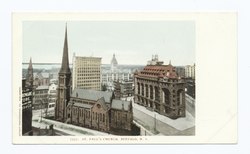
The Boston Avenue United Methodist Church, located in downtown Tulsa, Oklahoma, and completed in 1929, is considered to be one of the finest examples of ecclesiastical Art Deco architecture in the United States, and has been placed on the National Register of Historic Places. Built by a congregation of the Methodist Episcopal Church, South, it was designated a National Historic Landmark in 1999. It has 15 floors.

The Church of the Ascension is an Episcopal church in the Diocese of New York, located at 36–38 Fifth Avenue and West 10th Street in the Greenwich Village neighborhood of Manhattan New York City. It was built in 1840–41, the first church to be built on Fifth Avenue and was designed by Richard Upjohn in the Gothic Revival style. The interior was remodeled by Stanford White in 1885–88.
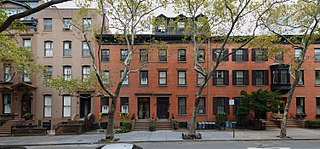
The Brooklyn Heights Historic District is a historic district that comprises much of the Brooklyn Heights neighborhood of Brooklyn, New York City. It was named a National Historic Landmark in January, 1965, designated a New York City Landmark in November, 1965, and added to the National Register of Historic Places in October, 1966.
Henry C. Dudley (1813–1894), known also as Henry Dudley, was an English-born North American architect, known for his Gothic Revival churches. He was a founding member of the American Institute of Architects and designed a large number of churches, among them Saint Paul's Episcopal Cathedral in Syracuse, New York, built in 1884, and Trinity Church, completed in 1858.

St. Andrew's Episcopal Church, also known as St. Andrew's Church is a historic church building on County Highway 12 in Prairieville, Alabama. Built by slaves in 1853, it is a remarkably well-preserved example of Carpenter Gothic architecture, its design apparently taken from a book by Richard Upjohn. St. Andrew's was added to the National Register of Historic Places on November 7, 1973, and was declared a National Historic Landmark on the same day. Public access is allowed to this National Historic Landmark.

St. Peter's Episcopal Church, also known as St. Peter's Church, is located in downtown Albany, New York, United States. It was designed in the mid-19th century by Richard Upjohn and his son Richard M. Upjohn in the French Gothic Revival architectural style. It was listed on the National Register of Historic Places in 1972, and designated a National Historic Landmark eight years later. It is also a contributing property to the Downtown Albany Historic District.

All Saints' Memorial Church is a small stone Gothic-style Episcopal church built in 1864 by Richard Upjohn in Navesink, New Jersey. A National Historic Landmark, the church complex, which includes the rectory, stable, and carriage house, is a well-preserved example of the late work of Upjohn.
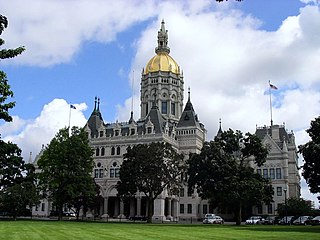
Richard Michell Upjohn, FAIA, was an American architect, co-founder and president of the American Institute of Architects.
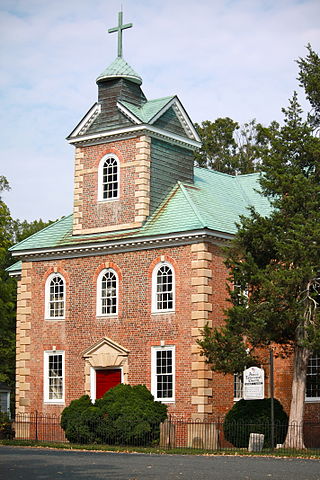
Aquia Church is a historic church and congregation at 2938 Richmond Highway in Stafford, Virginia, USA. It is an Episcopal congregation founded in 1711, that meets in an architecturally exceptional Georgian brick building that was built in the 1750s. The building was designated a National Historic Landmark in 1991 for its architectural importance. It maintains an active congregation with a variety of programs and outreach to the community.

Christ Episcopal Church, also known as Christ Church on Capitol Square, is an Episcopal church at 120 East Edenton Street in Raleigh, North Carolina. Built in 1848–53 to a design by Richard Upjohn, it is one of the first Gothic Revival churches in the American South. The church was built for a parish established in 1821; its minister is the Rev. James P. Adams. It was declared a National Historic Landmark in 1987.
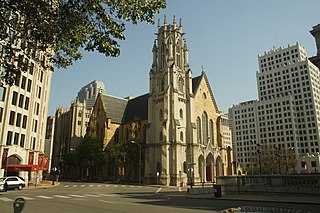
Christ Church Cathedral is the Episcopal cathedral for the Diocese of Missouri. It is located at 1210 Locust Street in St. Louis, Missouri. The dean of the cathedral is the Very Reverend Kathie Adams-Shepherd. Adams-Shepherd is also the first female dean of this cathedral. Built during 1859–67, it is one of the few well-preserved surviving works of Leopold Eidlitz, a leading mid-19th-century American architect, and was designated a National Historic Landmark in 1994 for its architecture.

St. Mark's Episcopal Church, now the Episcopal Parish of St. Mark and St. John, is a historic Episcopal church at 21 Race Street in Jim Thorpe, Carbon County, Pennsylvania. Completed in 1869, it is a prominent example of Gothic Revival architecture designed by that style's leading proponent, Richard Upjohn. It is one of Upjohn's last designs, and was funded by the congregation, which contained eight millionaires whose fortunes were made in the coal fields and railroad industry. It was added to the National Register of Historic Places in 1977, and declared a National Historic Landmark in 1987.

St. Paul's Protestant Episcopal Church, more commonly called Old St. Paul's Church today, is a historic Episcopal church located at 233 North Charles Street at the southeast corner with East Saratoga Street, in Baltimore, Maryland, near "Cathedral Hill" on the northern edge of the downtown central business district to the south and the Mount Vernon-Belevedere cultural/historic neighborhood to the north. It was founded in 1692 as the parish church for the "Patapsco Parish", one of the "original 30 parishes" of the old Church of England in colonial Maryland.

There are 75 properties listed on the National Register of Historic Places in Albany, New York, United States. Six are additionally designated as National Historic Landmarks (NHLs), the most of any city in the state after New York City. Another 14 are historic districts, for which 20 of the listings are also contributing properties. Two properties, both buildings, that had been listed in the past but have since been demolished have been delisted; one building that is also no longer extant remains listed.

Trinity Church, also known as Trinity Episcopal Church, is an historic Episcopal church in Warsaw, Wyoming County, New York. The Carpenter Gothic style frame church was built in 1853-1854 and closely follows the plan and elevations of a country church published by Richard Upjohn (1802–1878) in his book Upjohn's Rural Architecture (1852). Upjohn's connection with the design of the church has been confirmed by a letter dated December 30, 1853.
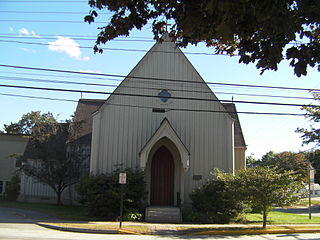
St. Paul's Episcopal Church is a historic church at 27 Pleasant Street in Brunswick, Maine. Built in 1845, it is a distinctive early example of a modest Carpenter Gothic design by Richard Upjohn, then already well known for his larger-scale Gothic churches. The building was listed on the National Register of Historic Places in 1978. The rector is Rev. Carolyn H. Eklund.

Robert W. Gibson, AIA, was an English-born American ecclesiastical architect active in late-nineteenth- and early-twentieth-century New York state. He designed several large Manhattan churches and a number of prominent residences and institutional buildings.

The Architecture of Buffalo, New York, particularly the buildings constructed between the American Civil War and the Great Depression, is said to have created a new, distinctly American form of architecture and to have influenced design throughout the world.

John Welch (1825-1894) was a Scottish-born American architect of Brooklyn, New York, who designed numerous churches. He was one of the founders of American Institute of Architects.


